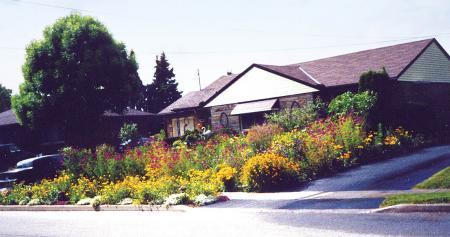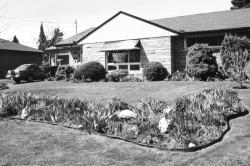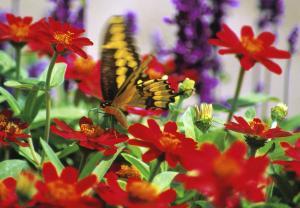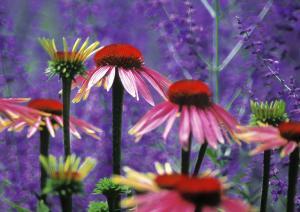By Theresa Forte
 | |||
 | Certified as a Wildlife Habitat by the Canadian Wildlife Federation, this garden by Loretta Burke in Niagara Falls, Ont. provides a natural sanctuary for birds and butterflies. | ||
Liz Primeau, is well-known among garden enthusiasts as the founding editor of Canadian Gardening magazine, host of HGTV's Canadian Gardening TV, editor of Gardening for Canadians for Dummies and author of Front Yard Gardens Growing More Than Grass. Recently she addressed a group at the Spring Open House at the Glendale Campus of Niagara College, in St. Catharines, Ont.
It was her topic, "Front Yard Gardens" that caught my attention. Over the past few years, I have been debating the merits of pulling out our front lawn and completely redesigning the space as a garden. In my mind, the lawn is slated for demolition, but the physical work remains to be done. Perhaps her talk would provide the final incentive to get the project underway.
Primeau described a sort of epiphany she experienced on a visit to Holland. She discovered a home, similar in shape and size to her own, that had the most wonderful front garden: "It undulated with plants, spring bulbs of every hue, perennials pregnant with buds, rhododendrons, mounding mugho pines and nest spruce, all of which flowed continuously from the foundation of the house to the roadside."
She continued: "It was more than this dwelling's resonance with my own little house that suddenly made me realize how much I wanted a front garden; for years I'd been an unquestioning gardener who accepted the unwritten rule of the lawn, experimenting with garden styles in my backyard and leaving the grass for my neighbours to approve of and my husband to mow."
|
I immediately empathized with her. Heads in the audience began to nod with approval, we all understood her feelings, she was speaking to the converted. Primeau described the difference between her lush back garden and her typical, suburban front garden. The meadow-like back garden offered natural beauty and diversity of plants and wildlife, while the front yard was "A no-man's land of barren grass stretching from the house to the road in the front, edged with sad shrubs, a concrete sidewalk and a big, black asphalt driveway." She goes on: "When I walked around to the front, the atmosphere changed: no bugs, no birds, no butterflies, no animals. Worse, it lacked personality." The Primeau garden enjoys a sunny exposure and has a base of thin, sandy soil. Her plant choices reflect these conditions, keeping watering and maintenance to a minimum. Perennials include easy-care candidates such as catmint (Nepeta), lamb's ears (Stachys byzantina), cushion spurge (Euphorbia), lady's mantle (Alchemilla mollis), creeping baby's breath (Gypsophila repens), blue fescue (Festuca glauca), rock cress (Aubrieta), campanula, lavender, purple coneflower (Echinacea purpurea), thyme, moss, phlox, Russian sage (Perovskia atriplicifolia), veronica, allium, mallow (Malva) and bugleweed (Ajuga reptans). Woody shrubs and small trees such as redbud (Cercis), rhododendrons (sheltered by evergreens), 'The Fairy' rose, Japanese kerria, red-twig dogwood (Cornus), magnolia, mugho pine, Japanese maple (Acer palmatum) and purple smokebush (Cotinus coggygria) create a strong backbone for the plan. Spring flowering bulbs and self-seeding annuals such as California poppies, oxeye daisies, mullein and clary sage have been liberally planted for additional interest.
At the Forte home Last fall, the personality of the space was transformed even further with a new concrete driveway and enlarged entrance terrace. My plan is to position a row of large flat rocks along the front property line and about a third up the side of the new driveway, and fill the former lawn space with topsoil. This is will level the sloping grade of the front garden and create a nice finish. The area will then be planted with ornamental grasses, perennials, spring bulbs and a selection of flowering native Carolinian shrubs. I can hardly wait to get started with my own planting, following Primeau's footsteps and finally transform our suburban front yard into the garden of my dreams. Theresa M. Forte is a columnist, photographer and garden consultant based in Niagara Falls, Ont. |


